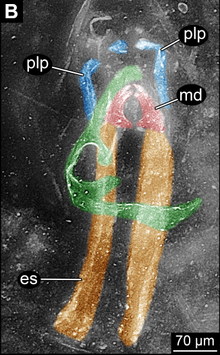Rhyniognathais an extinctgenusof arthropod of disputed placement. It has been considered in some analyses as the oldestinsectknown, as well as possibly being aflying insect.[1]Rhyniognathais known from a partial head with preserved mouthparts from theEarly DevonianagedRhynie chertaround 400 million years ago, when Earth’s first terrestrialecosystemswere being formed. The type, and only species isR. hirsti,which was named and described in 1928.[2]Other analyses have interpreted the specimen as amyriapod.
| Rhyniognatha Temporal range:Early Devonian,
| |
|---|---|

| |
| Specimen ofRhyniognatha | |
| Scientific classification | |
| Domain: | Eukaryota |
| Kingdom: | Animalia |
| Phylum: | Arthropoda |
| Genus: | †Rhyniognatha Tillyard, 1928 |
| Species: | †R. hirsti
|
| Binomial name | |
| †Rhyniognatha hirsti Tillyard,1928
| |
Evidence
editThe head part of a specimen, preserved in a fragment ofRhynie Chert,was collected in 1919 by the Reverend W. Cran, who provided it to S. Hirst,Samarendra Maulikand D.J. Scourfield. Hirst and Maulik published a report in 1926; in it they describedRhyniella praecursor,which is now known to be aspringtail.Several other pieces, including theRhyniognathahead, were also described as "supposedlarvalinsect "though yet unnamed.[3]The specimen was named asRhyniognatha hirstiin 1928 by entomologist Robin J. Tillyard.[2]It was later donated by D.J. Scourfield to theNatural History MuseuminLondonwhere it is currently displayed on a microscope slide.[4]In 2004Michael S. EngelandDavid A. Grimaldi(2004) analyzedRhyniognatha hirsti'smouthparts,and came to the conclusion thatRhyniognathalikely had wings, as they determined the mouthparts resembled those of amayfly,a flying insect.[5]Nevertheless, a detailed reanalysis by Carolin Haug & Joachim T. Haug in 2017 came to a different interpretation, concluding that the identity ofRhyniognatha hirstias amyriapod,specifically ascutigeromorphcentipede,was better supported by the available evidence, without being able to exclude an insect identity completely.[6]
References
edit- ^The University of AberdeenImage of type specimen (University of Aberdeen)
- ^abR. J. Tillyard. 1928. Some remarks on the Devonian fossil insects from the Rhynie chert beds, Old Red Sandstone.Transactions of the Entomological Society of London76:65-71
- ^Hirst, Stanley; Maulik, S. (1926)."On some Arthropod Remains from the Rhynie Chert (Old Red Sandstone)".Geological Magazine.63(2):69–71.Bibcode:1926GeoM...63...69H.doi:10.1017/S0016756800083692.ISSN1469-5081.
- ^Andrew Ross."The oldest fossil insect in the world".Natural History Museum.
- ^Engel, Michael; Grimaldi, David (12 February 2004)."New Light Shed on the Oldest Insect".Nature.427(6975):627–630.Bibcode:2004Natur.427..627E.doi:10.1038/nature02291.PMID14961119.S2CID4431205.
- ^Carolin Haug & Joachim Haug (2017)."The presumed oldest flying insect: more likely a myriapod?".PeerJ.5:e3402.doi:10.7717/peerj.3402.PMC5452959.PMID28584727.